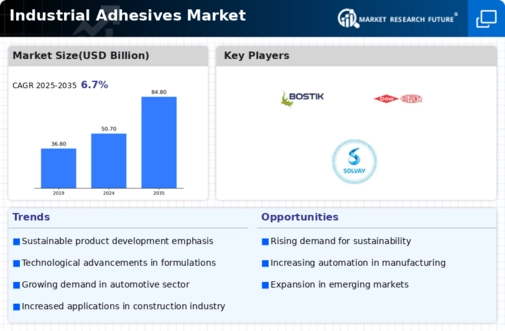Top Industry Leaders in the Industrial Adhesive Market
 In the bustling world of industrial fabrication, where metals meet wood, glass encounters ceramics, and plastic bonds with concrete, the unsung heroes are the industrial adhesives. These sticky sentinels hold our modern infrastructure together, from towering skyscrapers to sleek aircrafts, and their market reflects this crucial role. Let's peel back the layers of this dynamic landscape, exploring the key players, their winning strategies, and the factors that determine who sticks around at the top.
In the bustling world of industrial fabrication, where metals meet wood, glass encounters ceramics, and plastic bonds with concrete, the unsung heroes are the industrial adhesives. These sticky sentinels hold our modern infrastructure together, from towering skyscrapers to sleek aircrafts, and their market reflects this crucial role. Let's peel back the layers of this dynamic landscape, exploring the key players, their winning strategies, and the factors that determine who sticks around at the top.
Key Players and Winning Strategies:
Global Adhesives Titans: Companies like Henkel, 3M, Dow, Bostik, and H.B. Fuller hold significant market share, leveraging their vast production capacities, diverse product portfolios, and established global footprints. Henkel, for instance, dominates the high-performance epoxy adhesives segment, catering to demanding industrial applications.
Regional Champions: Players like Sika AG (Switzerland), Arkema (France), and Sinopec Catalyst (China) excel in specific regions, capitalizing on local knowledge and strong relationships with regional manufacturers. Sinopec caters to the Chinese market with cost-effective and customized adhesive solutions.
Sustainability Champions: Emerging players like EVOCHEM and Bluegreen Adhesives are carving a niche through eco-friendly offerings. EVOCHEM focuses on developing bio-based and readily-recycled adhesives, aligning with the growing demand for sustainable solutions.
Niche Specialists: Smaller players like Cenospheres International and Permabond push boundaries with cutting-edge advancements. Cenospheres International's unique cenosphere-based adhesives offer improved thermal stability and shock resistance, while Permabond caters to specialty applications like medical device assembly.
Factors Shaping Market Share:
-
Adhesive Performance and Reliability: Meeting diverse industry needs with strong bonding strength, resistance to temperature extremes, chemicals, and vibrations is crucial. Henkel's high-performance epoxies exemplify this focus.
-
Sustainability and Environmental Footprint: Reducing solvent emissions, utilizing renewable feedstocks, and minimizing waste generation are becoming essential criteria for market penetration, driven by stricter regulations and eco-conscious consumers. EVOCHEM's bio-based adhesives resonate with this trend.
-
Cost-Effectiveness and Value Proposition: Balancing high performance with competitive pricing is vital, particularly in price-sensitive segments like packaging and assembly. Sinopec's cost-effective adhesives find favor in budget-conscious markets.
-
Technological Advancements and Applications: Constant research and development of new adhesive formulations with additional functionalities, like thermal conductivity or self-healing, opens up new avenues for market growth. Cenospheres International's thermally-stable adhesives illustrate this trend.
Competitive Landscape
The Most Prominent Major Key Players in the Industrial Adhesives Market all across the globe are mentioned below:
- B Fuller Company (US)
- Pidilite Industries Ltd. (India)
- 3M (US)
- BASF SE (Germany)
- Bostik (US)
- DowDuPont (US)
- Mitsubishi Chemical Corporation (Japan)
- Lord Corporation (US)
- Hitachi Chemical Co. Ltd. (Japan)
- Henkel AG & Co. KGaA (Germany)
- Avery Dennison Corporation (US)
- Solvay (US)
Recent Developments
-
September 2023: Cenospheres International successfully tests its cenosphere-based adhesive prototype for high-stress industrial applications, offering a potential game-changer in performance and efficiency.
-
October 2023: Permabond introduces a novel conductive adhesive for electronic interconnects, catering to the burgeoning electronics market.
-
November 2023: Sika AG collaborates with a university research group to develop self-healing adhesives for infrastructure repair, opening doors for extended lifespan and reduced maintenance costs.

